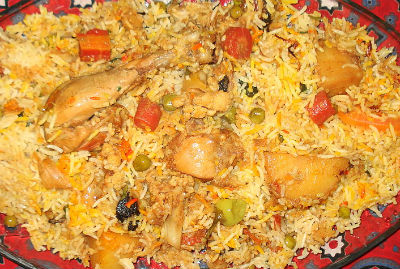

Īccording to Vishwanath Shenoy, the owner of a biryani restaurant chain in India, one branch of biryani comes from the Mughals, while another was brought by the Arab traders to Malabar in South India. Over time, the dish became biryani due to different methods of cooking, with the distinction between "pulao" and "biryani" being arbitrary. Armies would prepare a one-pot dish of rice with whichever meat was available. She speculates that the pulao was an army dish in medieval India. Īccording to Pratibha Karan, who wrote the book Biryani, biryani is of South Indian origin, derived from pilaf varieties brought to the Indian subcontinent by Arab traders. A similar theory, that biryani came to India with Timur's invasion, appears to be incorrect, because there is no record of biryani having existed in his native land during that period.

The 16th-century Mughal text Ain-i-Akbari makes no distinction between biryanis and pilaf (or pulao): it states that the word "biryani" is of older usage in India. Īnother theory claims that the dish was prepared in India before the first Mughal emperor Babur conquered India. Indian restaurateur Kris Dhillon believes that the dish originated in Persia, and was brought to India by the Mughals. Īccording to historian Lizzie Collingham, the modern biryani developed in the royal kitchens of the Mughal Empire (1526–1857) and is a mix of the native spicy rice dishes of India and the Persian pilaf. In South India, where rice is more widely used as a staple food, several distinct varieties of biryani emerged from Hyderabad Deccan (where some believe the dish originated ) as well as Tamil Nadu ( Ambur, Thanjavur, Chettinad, Salem, Dindigal), Kerala ( Malabar), Telangana, and Karnataka ( Bhatkal) where Muslim communities were present. In North India, different varieties of biryani developed in the Muslim centres of Delhi ( Mughlai cuisine), Rampur, Lucknow ( Awadhi cuisine) and other small principalities. The exact origin of the dish is uncertain. Another theory states that it is derived from biryan or beriyan ( Persian: بریان), which means "to fry" or "to roast". One theory states that it originated from birinj ( Persian: برنج), the Persian word for rice. 4 Preparation styles: pakki versus kacchi biryaniīiryani is an Indo-Aryan word derived from the Persian language, which was used as an official language in different parts of medieval India by various Islamic dynasties.2.1 Difference between biryani and pulao.


 0 kommentar(er)
0 kommentar(er)
